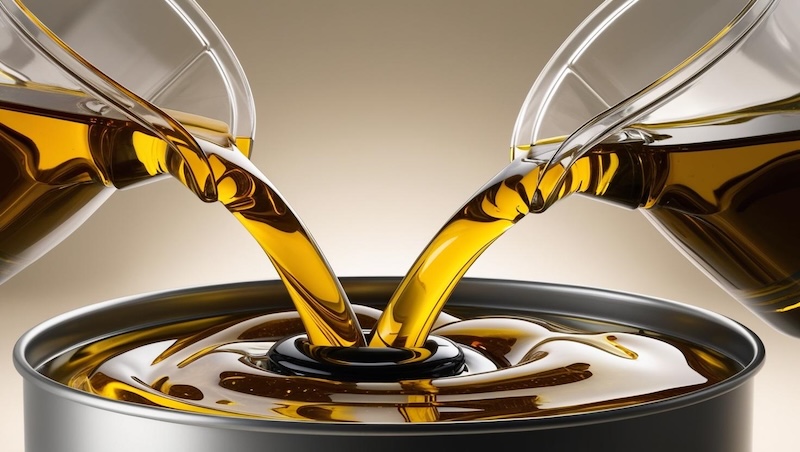The Wrong Mix Can Bring Down Your Turbine
Ensuring the reliability and efficiency of wind turbines requires a deep understanding of the fluids that keep them running smoothly. To that end, compatibility testing plays a critical role in preventing costly issues that arise from mixing incompatible lubricants. This article explores the significance of fluid compatibility testing in industries such as power generation, highlighting its ability to enhance equipment reliability, reduce maintenance costs, and maintain compliance with industry standards. By delving into key testing protocols, such as ASTM D7155, and providing actionable insights, this articles serves as a comprehensive guide for those aiming to safeguard their equipment and optimize performance through diligent lubrication management.

Overview
Fluid compatibility testing is an assessment as to whether two or more fluids can be mixed with each other without adverse chemical, physical, or performance-related issues. It can also be a requirement to meet certain safety and compliance regulations.
Problems caused by fluid incompatibility include excessive foaming, precipitate, or deposit formation and loss of essential performance traits such as water separability. Testing is critical for heading off these and other serious issues. Following are eight benefits of testing.
- Enhanced equipment reliability: Ensures that mixed oils will not lead to issues such as sludge formation, sedimentation, or changes in viscosity that could compromise machine performance; helps prevent unplanned equipment shutdowns due to oil-related issues.
- Prolonged oil life: Identifies potential incompatibilities that may accelerate oil degradation, such as oxidative breakdown or additive depletion; maintains the long-term stability of oil (reducing the frequency of oil changes).
- Reduced maintenance costs: Avoids remediation in terms of costly repairs and clean-ups; helps in planning and executing cost-effective lubrication management practices.
- Operational safety: Prevents the formation of deposits or residues that might clog filters, lines, or nozzles; mitigates risks of overheating or equipment failure related to improper lubrication; avoids risks of foaming due to incompatible lubricants.
- Compliance with standards and regulations: Ensures that the oils used in critical machinery meet industry standards and do not violate warranty or regulatory requirements; demonstrates due diligence in lubricant management (important for audits and certifications).
- Supports oil transition and mixing: Facilitates safe oil transition when switching suppliers, formulations, or base stocks during maintenance or retrofitting; helps assess compatibility when small quantities of old oil remaining in equipment mix with a new oil type.
- Environmental benefits: Minimizes waste generation by reducing the likelihood of having to dispose of incompatible oil mixtures; ensures proper functioning of oil.
- Improved performance: Confirms that the mixture maintains optimal lubricating properties and enhances machine efficiency by ensuring consistent lubrication.
It’s also important to remember that “equivalent” or “comparable” lubricants are not the same as compatible lubricants. Equivalent or comparable lubricants meet similar performance standards, viscosity grades, and application requirements, making them suitable substitutes for one another in the same equipment. They are designed to deliver comparable functionality and meet the same industry or OEM specifications. However, these lubricants may have different formulations, including distinct base oils or additive packages, which can lead to adverse results if mixed, even though they perform similarly when used separately.
In contrast, compatible lubricants are specifically tested to ensure they can be mixed without causing chemical or physical issues such as sludge formation, additive precipitation or viscosity changes. Compatibility testing evaluates whether the lubricants will maintain stability and performance when combined. While equivalent lubricants focus on similar operational properties, compatibility ensures safe blending, making it critical to verify both aspects when switching or mixing lubricants to avoid equipment damage and operational disruption.

ASTM D7155: The Process
There are several considerations for determining the best compatibility test or slate of tests. Two of these considerations are:
Decide if you will test your current in-use fluid with the replacement fluid(s). If you have one lubricant system that’s transitioning to a new oil, it’s a good idea to test the used fluid with the replacement fluid.
- Determine which mixtures you would like tested. ASTM D7155 calls for at least one mixture in the ratio of 50:50. Additional mixtures can be added if appropriate. If you are doing a complete change out, but some residual fluid may be present in the system and could mix with the new fluid, then adding a 90 percent new oil to 10 percent used oil mixture is recommended. If the replacement fluid will be gradually added to the existing fluid, then three mixtures are recommended, either 90:10, 50:50, and 10:90 or 25:75, 50:50, and 75:25.
Compatibility testing considerations should be based on ASTM D7155 “Standard Practice for Evaluating Compatibility of Mixtures of Turbine Lubricating Oils” as a guideline. This protocol helps to determine whether mixing two fluids would negatively affect performance, stability, or system integrity. However, ASTM D7155 is not meant to establish the performance of a hydraulic fluid, only its compatibility when mixed with another fluid.
ASTM D 7155 categorizes these tests into four tiers; the first two tiers are required for accurate results; the 2nd two tiers are optional.
Tier I: Visual Inspection: calls for heating the mixtures along with neat samples of the constituent oils for a period of time, then incubating at room temperature, with visual assessments of the mixtures for clarity and development of precipitates after both the heating and room temperature incubation. If no signs of incompatibility are observed during Tier I, then Tier II, Tier III, and Tier IV testing should be considered.
Tier II: Interfacial Properties tests:
- Demulsibility ASTM D1401
- Foam ASTM D892
- MPC ASTM D7843
- Air Release ASTM D3427
Tier III: Physical and Chemical Properties tests:
- V40 ASTM D445
- V100 ASTM D445
- Viscosity Index ASTM D2270
- Color ASTM D1500
- Acid Number ASTM D974
- Additive Metals ASTM D5185
- Water Content ASTM D6304
Tier IV: Specific Performance Properties tests:
- RPVOT ASTM D2272
- Rust ASTM D665
- Copper Corrosion ASTM D130
Avoiding the consequences of incompatible oils
Even with the most diligent compatibility testing, there can still be challenges due to real-world variability — fluids behave differently in lab tests than in field conditions. Testing can also become complex when multiple fluids (lubricants, coolants, additives, etc.) are used together. Given all this, while lubricant compatibility testing cannot guaranteecompatibility, it can predict compatibility.

Lubricants usually get mixed in one of three ways:
- The intentional addition of a different lubricant to a machine: The plant may be trying to consolidate lubricants in use; the current product may be discontinued or there may be supply chain issues.
- The accidental addition of the wrong lubricant to the machine: This is usually the result of poor identification and storage processes.
- Inadvertent contamination with a different lubricant during operation: There are a number of possible scenarios, such as a leaking hydraulic line dripping hydraulic fluid into a gearbox.
There are consequences — often serious — for mixing incompatible fluids. These include loss of critical performance characteristics of the lubricant such as the ability to separate from air, the ability to separate from water, loss of rust/corrosion protection, etc. Mixing incompatible lubricants can also result in drop out of additives and/or formation of insoluble materials, which can clog filters and interfere with the functioning of moving parts. The good news is that, with due diligence and testing, this can be avoided.
Preventing the mixing of incompatible lubricants involves careful planning, proper procedures, and verification to ensure equipment reliability and optimal performance. Here are some precautions to take:
- Identify and document lubricants in use: Maintain a comprehensive list of all lubricants used in the facility, including specifications, base oils, and additive types. Label storage containers, transfer equipment, and lubrication points to avoid accidental mixing.
- Consult manufacturer recommendations: Always follow OEM and lubricant manufacturer guidelines regarding acceptable substitutes and compatibility; don’t hesitate to obtain technical support from manufacturers to verify the equivalence of specific lubricants.
- Avoid mixing whenever possible: Drain and flush systems thoroughly when switching lubricants to minimize residual oil that could cause incompatibility; use dedicated equipment for each lubricant type (i.e. pumps, funnels, and storage tanks) to avoid cross-contamination.
- Implement a lubrication management program: Train personnel on the importance of lubricant compatibility and proper handling procedures; use clearly marked containers to differentiate lubricants; and regularly audit lubrication practices to ensure adherence to established protocols.
- Monitor oil condition: Perform routine oil analysis to detect early signs of incompatibility, such as unusual sludge, varnish, or changes in physical properties. Then respond promptly to anomalies by investigating and correcting the root cause.
- Take advantage of compatibility testing: Perform compatibility testing through a qualified laboratory before mixing lubricants, especially during oil changeovers or when topping off with a different product; test for changes in properties such as viscosity, sedimentation and chemical stability to confirm compatibility.
By implementing these practices, the risk and consequences of mixing incompatible lubricants can be greatly reduced — preventing costly equipment damage, downtime, and maintenance issues.
Givem the possible consequences, compatibility testing through a qualified lab is a relatively minor expense with the potential to deliver significant cost-savings.
Al Yates is the Vice President of Sales and Marketing for Eurofins TestOil. He is responsible for leading the industrial and transportation sales team. With valuable experience in robotics/automation, he creates workflow automations that lead to company-wide efficiency. With a B.S. in Biology/Chemistry from Piedmont University, Al leverages his scientific and sales background to support the company’s growth goals.
Eurofins TestOil | testoil.com
Author: Al Yates
Volume: 2025 July/August








